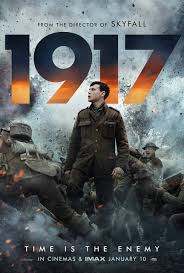
Anyone who follows this blog knows that I am a stickler for story structure. When I evaluate scripts, especially for new and/or undiscovered writers, I make it a point to pay particular attention to the structure of the story and note whether that changes in acts are happening in the right places. My thinking is that when you’re an unknown commodity, you need to demonstrate that you can follow the rules before people will trust you to break them. Sam Mendes is obviously at the point where he can break them, because 1917 broke many of the rules of conventional screenwriting, and yet it got made and became one of the most popular and successful films of 2019. However, even though it did not really follow the typical 3-Act structure, the script still works because it follows a very definite Hero’s Journey.
On one of my social media feeds a person commented that 1917 was nothing more than a glorified video game. We followed the characters through a series of levels having to confront a series of Bosses. When they defeated that level’s Boss, they leveled up and moved on to the next level and the next Boss. Sure it was entertaining and intense, the poster admitted, but it was a video game, not a movie.
You’ll also know, if you follow this blog, that I’m not a fan of Road Movies for the very reasons listed above. I’ve never articulated it that way, but many of those principles apply to why I’m not a fan of that style of storytelling. The stories are often episodic and you can often change the order of the episodes and not change the movie’s story at all.
That is where I part ways with the poster about 1917. Yes, it is a road movie, and on the surface the argument could be made that it’s an episodic story. However, you could not change the order in which they occur. This story follows a definite path which creates a definite arc for the Hero, and that is the big difference in 1917. Or, as the poster pointed out, the characters are doing nothing more than defeating whatever Boss is in front of them and then moving on to the next level. I would like to respectfully disagree and point out that if you break the story down to its Hero’s Journey components you would see that nothing could be farther from the truth. Even though the characters go on a journey, and this is an episodic story, the screenplay provides plenty of examples of quality storytelling and we have a through line that road movies are often missing. This through line provides the spine for the story and shows us that the movie works as a continuous story rather than the episodes that make it up.
For your consideration, here is a breakdown of the Hero’s Journey components in the film 1917.
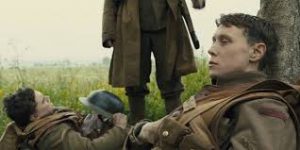
Ordinary World – We meet Lance Corporal Blake (Dean-Charles Chapman) and Lance Corporal Schofield (George McKay) as they’re resting on a short leave. A Staff Sergeant kicks Blake awake and tells him he’s to report to the general and to bring a friend. He taps Schofield and the two of them go back to the trenches to the General’s quarters.
Call to Adventure – Once they’ve arrived, they’re informed by General Erinmore (Colin Firth) that a major assault is planned because the Germans have baited the 2nd Devers into a trap, and that the attack will fail and that Blake’s brother, who’s a member of that regiment, will be killed along with the other 1600 men he’s with. They get orders to get to the 2nd Devers and bring a letter to Col. Mackenzie ordering him to call off the attack, which is planned for just after dawn the next day. That gives the characters a ticking clock, which will come into play almost immediately, and will stay with us throughout the film.
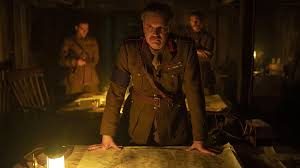
Refusal of the Call – Schofield shows some reluctance thinking the Germans will be waiting for them. Then he wants to talk to Blake about it because he wants to at least wait until it’s dark. Blake, however, is only thinking of his brother and wants to move out right away. The surveillance says that the Germans have withdrawn so they should be able to cross No Man’s Land, but Schofield isn’t convinced and Blake recklessly rambles ahead.
Meeting the Mentor – The first of many, Lt. Leslie gives them instructions on how to get across No Man’s Land. Like the Archetypal Mentors of old, he gives them a gift to help them on their journey in the form of flare guns to fire off if they make it to the other side.
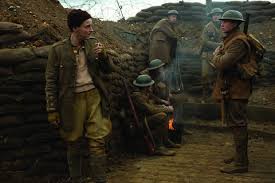
Crossing the First Threshold – Generally the beginning of Act II, it happens early in this film, just under 17 minutes in. They climb the ladders from the trenches and into No Man’s Land. They have left the Ordinary World and relative safety of the Trenches behind, and are now in the Special World of No Man’s Land and whatever dangers lie beyond.
Tests, Allies & Enemies – They start across No Man’s Land. The Markers that Lt. Leslie gave them are there. They make it to the German lines, dodging barbed wire, trenches and scout planes. They make it to the German trenches. Struggling to find a way through, they come across a tunnel that leads to a huge barracks. Schofield finds a trip wire but before they can move a rat sets it off blowing apart the chamber and burying Schofield in debris. Blake manages to get him up and drags him out of the caverns. The near-death experience fills Schofield with regret for Blake picking him, and the allies nearly become enemies. However Schofield gets his wits back and they move on.
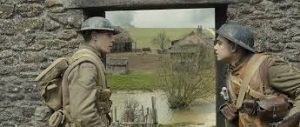
The Approach – Schofield tells Blake he’ll probably get a medal for saving his life. We learned earlier that Schofield received a medal that he no longer has. He admits to Blake that he swapped it for a bottle of wine. To him it was nothing more than a piece of tin. He didn’t want to take it home because he hated being there when he was there on leave. They arrive at a bombed out house surrounded by cherry blossoms. Blake is an expert on cherries because his mother has an orchard back home. They decide to investigate the house to make sure that it’s abandoned, as they suspect. Finding nothing in the house, Schofield moves out to the shell of what was once a barn where he finds a bucket of fresh milk that he pours into his empty canteen. Blake joins him and they watch the end of dogfight playing out in the distance. The German plane is shot down and they’re nearly killed when it crashes into the barn.
Supreme Ordeal – They pull the German pilot from the flaming plane, his legs still on fire. Schofield wants to put him out of his misery, but Blake tells him to get water. Schofield runs to a nearby well, but he hears a commotion and turns just in time to see that German pilot stabbing Blake with a knife. Schofield shoots the German and tries to tend to Blake’s wound, but it’s too deep and too late. Schofield tries to get Blake to move, but it’s too painful, and they both come to the realization that Blake is dying. Blake tells Schofield that he’ll recognize his brother because the two of them look just like each other. Blake asks Schofield to write to his mom for him, to tell her that he wasn’t scared and that he loves her. Schofield assures Blake that he knows the way, reciting the directions for him. He promises to find the 2nd and warn his brother as Blake dies in his arms. Schofield pulls the orders from Blake’s jacket, removes a family ring and one of his dog tags. Schofield, the hero of this story, is now fully committed to the adventure.
Reward – As he pulls Blake’s body to a better resting spot, another couple of soldiers approach and help move him. He then meets Captain Smith (Mark Strong) who is second in command of a convoy heading to the new line. He offers to take Schofield part of the way. Schofield is put in a truck and tries to hold it together in front of other soldiers he doesn’t know as they laugh and tell stories. But the convoy gets bogged down by a downed bridge and Schofield has to move on alone. Smith wishes him luck and warns him to make sure there are witnesses when he presents the orders to Col. Mackenzie, warning him that some men just want the fight. Schofield crosses the debris of a downed bridge, but starts taking fire from a sniper. He manages to get a shot off and hits the sniper in the building he was hiding in. Going in to investigate, he shoots the sniper at close range, but the sniper manages to get a shot off, hitting Schofield in the helmet, knocking him unconscious.
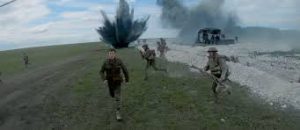
Resurrection – The longest stage of this particular Hero’s Journey starts off with a literal resurrection as Schofield wakes up hours later. It’s dark and he has no idea what time it is. He’s bleeding out of the back of his head and he struggles to his feet. Flares are illuminating the night sky and he sees the ruined town in front of him that he has to get through. As he traverses the streets he realizes that light means danger, as he can be seen by the enemy and must dodge their bullets. As he wanders, he stumbles across a German soldier who chases him, but he manages to escape into a small alcove where he finds a girl hiding with a baby. He asks if this is Accoust, and she says it is. She tells him that he should follow the river to get where he’s going, but he nearly passes out. She examines his wound and cleans it, archetypally healing him and bringing him back to life. The baby, too, is an archetypal symbol of rebirth just as the girl is the symbol of healing and of peace. He gives them food and the milk that he found in the barn, giving them an opportunity for rebirth as well. Interacting with the baby reignites Schofield’s desire to fulfill his mission and he notices that the morning is coming. The girl tries to get him to stay, but he has to go and his mission is reborn as well. He then stumbles upon a couple of drunken Germans and quietly strangles one as the other obliviously stumbles over and Schofield bullies by him. He jumps into the river to escape the city under a hail of more German bullets. The river is raging and sends him over a waterfall. About to give up, the river calms down and he sees Cherry Blossoms floating in the river, an archetypal and symbolic resurrection of Blake and he is again emboldened to continue. But he eventually runs into a mass of bloated and distended dead bodies collected along the river’s bank. After climbing over them, his emotions get the best of him and he breaks down until he hears the sound of singing in the woods. He follows the sound and finds a group of English soldiers listening to another soldier sing a song that is reminiscent of the ordeal that Schofield has just been through. He tells them he has to find the Devers, and they tell him that’s them. They tell him how to find Mackenzie, and he runs ahead. He ends up with them in a trench, but he can’t get through and the attack is about to commence. In perhaps the most famous scene of the movie, he jumps out of the trench, dodging artillery fire and other soldiers before making it to the headquarters of Col Mackenzie (Benedict Cumberbatch). At first unconvinced, McKenzie reads the orders and dramatically calls off the attack.
Return with the Elixir – The colonel’s aid congratulates Schofield on a job well done, but he doesn’t know where to find Blake. Since the First Wave had already gone over, he suggests that Schofield try the casualty tent behind the line. He makes his way there, and after nearly giving up on the search, he finally does find Lt. Blake. He gives him the unfortunate news that his brother died, presenting him with the family ring and dog tag. Lt. Blake, obviously devastated, holds back his emotions and tells Schofield to get to the mess tent. Schofield tells Lt. Blake that his brother was a good man and he saved his life. Lt. Blake confesses that he was glad Schofield was with him and they shake hands. Schofield walks behind a lonely tree off in the distance and sits. He removes from his pocket a photo of his daughters and one of his wife. He flips that one over and written on the other side are the words, “Come back to me”. Schofield closes his eyes and we cut to black.
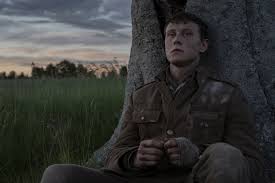
Unlike most successful films, this film’s story is largely told in one act. There is a very brief prologue of sorts, but once the adventure begins, there’s no all-is-lost moment or second plot point that changes the direction of the story. Blake and Schofield get their orders and from that point on the only thing they’re doing is trying to get to the 2nd to stop the attack. What makes it work for 1917 is that screenwriters Mendes and Kristy Wilson-Cairns meticulously followed the Hero’s Journey model that led to a compelling, intense and entertaining story.
Again, I don’t recommend this if you’re a writer breaking in to the business. As I mentioned before, you need to show that you can follow the rules before you try to break them. But it is possible. Not only is it possible, but when done properly, it can be very effective.